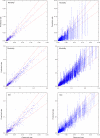Development and evaluation of the universal ACS NSQIP surgical risk calculator: a decision aid and informed consent tool for patients and surgeons
- PMID: 24055383
- PMCID: PMC3805776
- DOI: 10.1016/j.jamcollsurg.2013.07.385
Development and evaluation of the universal ACS NSQIP surgical risk calculator: a decision aid and informed consent tool for patients and surgeons
Abstract
Background: Accurately estimating surgical risks is critical for shared decision making and informed consent. The Centers for Medicare and Medicaid Services may soon put forth a measure requiring surgeons to provide patients with patient-specific, empirically derived estimates of postoperative complications. Our objectives were to develop a universal surgical risk estimation tool, to compare performance of the universal vs previous procedure-specific surgical risk calculators, and to allow surgeons to empirically adjust the estimates of risk.
Study design: Using standardized clinical data from 393 ACS NSQIP hospitals, a web-based tool was developed to allow surgeons to easily enter 21 preoperative factors (demographics, comorbidities, procedure). Regression models were developed to predict 8 outcomes based on the preoperative risk factors. The universal model was compared with procedure-specific models. To incorporate surgeon input, a subjective surgeon adjustment score, allowing risk estimates to vary within the estimate's confidence interval, was introduced and tested with 80 surgeons using 10 case scenarios.
Results: Based on 1,414,006 patients encompassing 1,557 unique CPT codes, a universal surgical risk calculator model was developed that had excellent performance for mortality (c-statistic = 0.944; Brier score = 0.011 [where scores approaching 0 are better]), morbidity (c-statistic = 0.816, Brier score = 0.069), and 6 additional complications (c-statistics > 0.8). Predictions were similarly robust for the universal calculator vs procedure-specific calculators (eg, colorectal). Surgeons demonstrated considerable agreement on the case scenario scoring (80% to 100% agreement), suggesting reliable score assignment between surgeons.
Conclusions: The ACS NSQIP surgical risk calculator is a decision-support tool based on reliable multi-institutional clinical data, which can be used to estimate the risks of most operations. The ACS NSQIP surgical risk calculator will allow clinicians and patients to make decisions using empirically derived, patient-specific postoperative risks.
Copyright © 2013 American College of Surgeons. Published by Elsevier Inc. All rights reserved.
Figures



References
-
- Walker JA. What is the effect of preoperative information on patient satisfaction? Br J Nurs. 2007;16:27–32. - PubMed
-
- Knops AM, Legemate DA, Goossens A, et al. Decision aids for patients facing a surgical treatment decision: a systematic review and meta-analysis. Ann Surg. 2013;257:860–866. - PubMed
-
- [May 2, 2013];Measure Application Partnership Pre-Rule Making Report. 2013 http://www.qualityforum.org/Publications/2013/02/MAP_Pre-Rulemaking_Repo....
Publication types
MeSH terms
Grants and funding
LinkOut - more resources
Full Text Sources
Other Literature Sources
Medical

